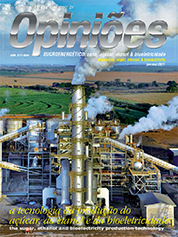Valdir José Torezan
Director of Projec - Projetos e Consultoria
Op-AA-27
Water
In the dawning of civilization, communities rose on the margins of rivers, given the importance of water as a mineral element. It was essential for consumption, irrigation and transportation, and to quench animal thirst. No differently than how forbearers viewed its importance, descendents too conceived initial projects of sugarcane plantations and small mills as using available water streams to begin operations.
They were the source of water, which was cooled and into which effluent generated in production activities of sugar and ethanol was dumped. With the coming about of the “Proálcool” program in the 1970’s, hundreds of new distilleries arose. Such growth accelerated state and federal government mechanisms aimed at implementing policies conceived for this industry.
On the other hand, new technologies became necessary to meet demands, which by then were environmental in nature, of sugar and ethanol business undertakings. During this period, new applications of water were introduced in the production process in mills. In the following decade, initial assessments showed astonishing figures concerning the industry’s water consumption.
The survey showed that consumption was between 14 and 20 m³/t of crushed sugarcane. More recently, new surveys showed a reduction in specific consumption to levels of less than 3 m³/t of crushed sugarcane (Manual on Preservation and Reutilization of Water in the Sugar-based Energy Agro Industry, 2009).
One should emphasize that in 1985, environmental regulatory bodies had already conceived their policies and began making considerable contributions to better industrial performance. By acting in a way so as to seek equilibrium between development and preservation, they requested by environmental licenses the increase of new tools.
Closing the circuits of water used in the industrial process and in the treatment of effluent, which until then was dumped in-natura into water streams, represented a major step ahead from the point of view of environmental preservation. In the 1990’s, with the realization of the United Nations Conference on Environment and Development (UNCED), measures to control the impact on the national production sector were established by environmental authorities.
Initiatives aimed at mitigating these impacts and improving environmental quality acknowledged the need to preserve hydric resources. Already well into the 21st. Century, and fostered by the launching of dual-fuel vehicles, the sugar and alcohol industry was back on track following the crisis at the end of the 1990’s. In this new phase, production is growing as never before.
New technologies predominate in the industry: mechanized harvesting, dry cleaning of sugarcane, efficiency in distillation, dehydration of vinasse, multiple use of water in the industrial process. This array of options brings new perspectives to the environmental field. Currently, the State of São Paulo Secretariat for the Environment, in a politically pioneering role, is in the process of publishing the Agro Environmental Zoning Guide for the sugar and ethanol industry, with the intent of establishing a set of policies for environmental preservation.
Recently, in light of the issuance of new environmental guidelines, the sugar and ethanol industry made improvements to equipment to allow the utilization and reutilization of water in the process, which implies in the reduction in consumption to a rate between 0.7 and 1.0 m3 of water per crushed ton.
The zoning, among other initiatives, sets forth industrial plants’ compliance with the maximum allowed sourcing as a function of water availability in the hydrographic basin in which they are located. One estimates that since its implementation, the Agro Environmental Protocol has accomplished reducing mills’ average sourcing in the State of São Paulo from 2.00 m³/t to 1.55 m³/t (www.ambiente.sp.gov.br/etanolverde).
Thus, measures associated with the reduction of water consumption in the industrial process will result in greater gains in terms of preservation of hydric resources. Furthermore, the launching of recovery programs for preservation areas will unleash continuous improvement. The recovery of degraded areas will result in environmental gains, which, reverted to maintenance of the quality of water supply sources, will serve to preserve them for future use.
In this regard, the 2009 paper on the Agro-ecological Zoning of Sugarcane, drawn up by Embrapa Solos, will serve as a means to guide the expansion of plantation areas and for the industrialization of sugarcane, identifying different development centers. Based on this document, the impacts associated with the activity may be discussed and mitigated on the occasion of the new project’s implementation, by associating the required preservation characteristics with maintenance of environmental quality.
Although the industry has expanded in areas viewed as environmentally correct, the State of São Paulo is concerned about such expansion and has proposed rules to protect hydric resources on the surface and also underground – the Guarani aquifer, one of the largest underground water reservoirs in the world. Anyone who in the past had any dealings with the sugar and ethanol industry, nowadays can easily observe how valued the utilization and reutilization of water is in industrial plants.




